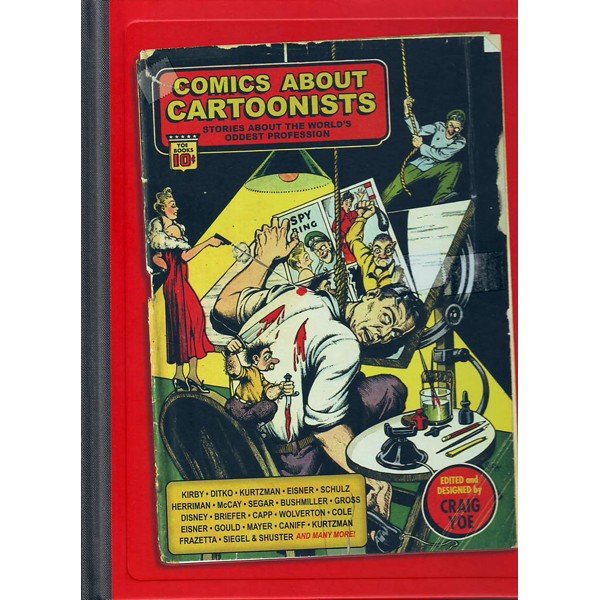Comics About Cartoonists: Stories About the World’s Oddest Profession
Editor: Craig Yoe
Publisher: IDW Publishing
Language: English
ISBN-10: 1-613-77346-3
ISBN-13: 978-1-613-77346-8
This is indeed an odd tome. It is a 229-page anthology of newspaper and comic book cartoonists drawing about their profession. Not “how to draw” lessons, either. Editor Yoe has combed the archives of old newspapers and comic books from roughly 1910 to 1960 and found “funny drawings” in which the cartoonists (sometimes working with scripts by others) have depicted stories about the cartooning profession. The reprinted newspaper strips are usually in black-&-white as they were published; the comic-book reprints are in full, garish color.
Many of the comic-book stories are about cartoonists who draw themselves into their own stories. These range from realistic art – the “Inky” Wells cartoonist who falls in love with his model, from a 1955 romance comic, looks just like comic-book artist Jack Kirby, whose photograph is well-known – to the fanciful – surely funny-animal cartoonist Al Stahl (1958), who draws himself falling asleep at his drawing board and falls into his world of talking rabbits and policeman lions, did not really look like something out of a carnival funhouse’s distorted mirror. Most of the comic-book stories are six or eight pages. Famous newspaper cartoonists Milton Caniff (“Terry and the Pirates”; “Steve Canyon”) and Chester Gould (“Dick Tracy”) are present in one-page promo autobiographies in which they have drawn themselves in the style of their heroes. Bud Fisher (“Mutt and Jeff, 1919) draws himself getting contradictory demands from his editors for six panels (“More Republican jokes; No, more Democratic jokes; Ridicule the Bolsheviks; Lay off the Russians); in the seventh panel he commits suicide.
You wouldn’t believe how many artists of horror comics, the really hair-raising stuff that 1950s censors created the Comics Code Authority to prevent, drew themselves being eaten or dragged to Hell by their own monsters. The unique Basil Wolverton (1943) pens a tale of an inept cartoonist bouncing back & forth between the Daily Dally (“Paul Pill, Publisher. Please Don’t Pester Me, Punks!”) and Colic Comics Corp. (“Why be in the pen when you can be outside drawing with it?”). Winsor McCay (1906) has a “Dream of the Rarebit Fiend” in which he eats a “cheese pie” and gets so many compliments on his cartoons that his head swells until it explodes. There is a 1928 pre-Popeye sequence of “Thimble Theatre” by Elzie Segar in which Castor Oyl decides to become a newspaper publisher and tries to hire a comic-strip cartoonist.
Love comics, superheroes, spy adventures, funny animals, U.S. Army comics, gag comics, just about every kind of cartoons except Western comics. Yoe says that he looked for one with a cartooning slant but couldn’t find one. (There are no jungle adventure comics, either.) Humor, horror, “realism”, science-fiction, talking animals. Al Capp, Wally Wood, Ernie Bushmiller, George Herriman, Jerry Siegel & Joe Shuster, Charles Schulz, Jack Cole, Steve Ditko, Rube Goldberg, Will Eisner, Sheldon Mayer, Milt Gross, and more. There are 36 featured cartoonists, and several others represented by single panels, going back to Zim (Eugene Zimmerman) and Frank Bellew in the 1890s, and forward to B. Kliban in the 1980s. The overall effect is like one of the 52-page, “all in color for a dime” anthology comic books of the early 1940s, before the comic books specialized. You get a little bit of almost everything. “Comics About Cartoonists” will be devoured by the fans of mid-20th century popular culture, and the fans of individual popular newspaper and comic-book artists.
Warning: this $39.99 hardcover is printed on very thick paper and is heavy; 3 pounds.






